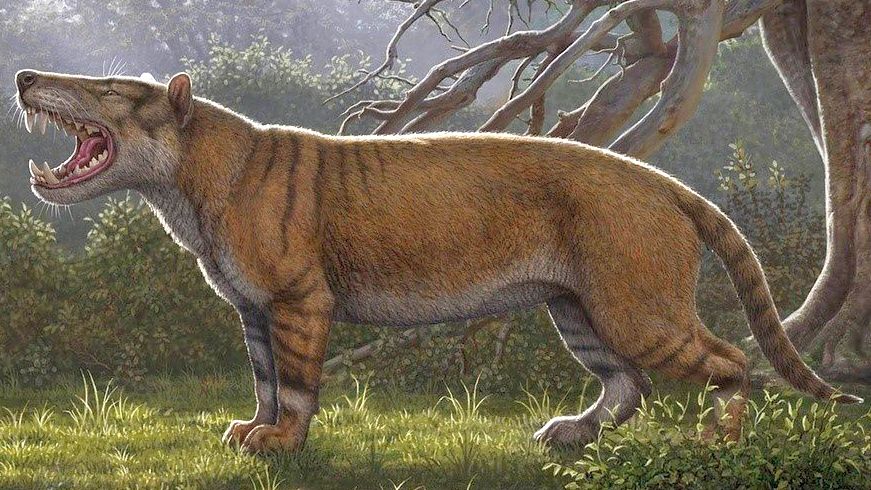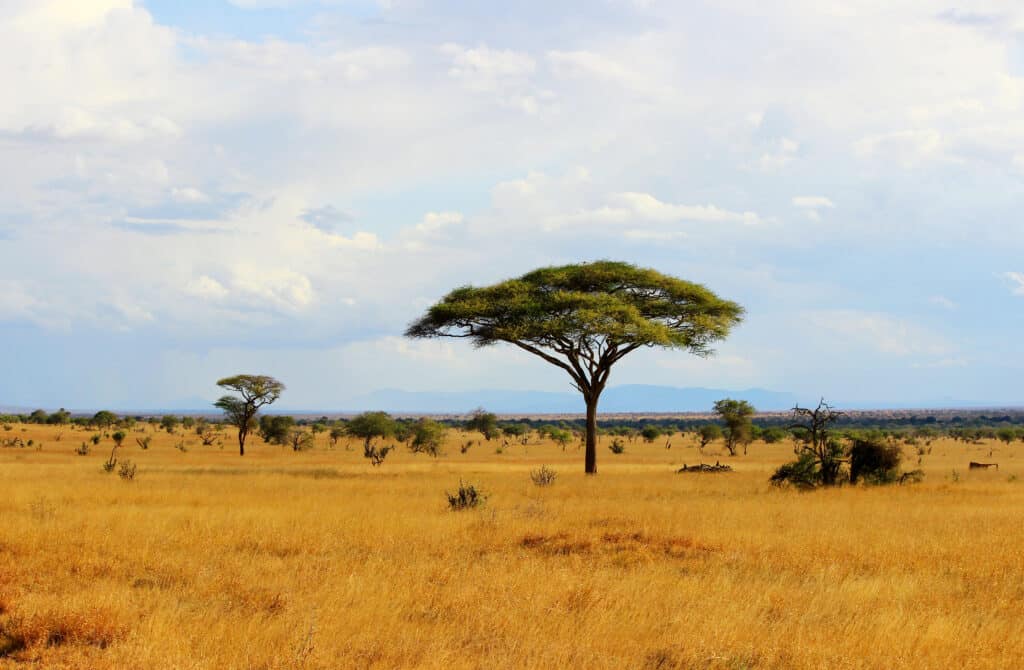The further back you go in history, the more you’ll find all kinds of fantastical beasts. Of course, these beasts are long gone, and we are left to speculate and hypothesize about the details of their lives.
In many cases, our understandings of ancient animals overlap with our modern mythological and fictional creations. For example, The Lord of The Rings is a treasure trove of mythological beasts that reflect some of the earth’s most ancient creatures.
Whether you take Gigantopithecus for a monstrous troll or think some of the early hominids looked a lot like Orks, you’re not far off.
In the early Miocene, what we would today associate with a creature right out of a fantasy movie roamed the earth; the Simbakubwa.
25 million years ago, this member of the suborder Hyaenodontidae roamed Kenya, looking an awful lot like a Warg. (If you recall, “Wargs” are the demonic wolves that Orks ride in the Lord of The Rings.)
Let’s explore what researchers know about Simbakubwa, looking into its part in past ecosystems and some of the behaviors it might have displayed.
What Was Simbakubwa?

The Simbakubwa Kutokaafrika could have weighed anywhere from 620 to 3,330 pounds!
©Mauricio Anton / CC BY-SA 4.0 – License
Simbakubwa Kutokaafrika’s bones make it look like a big cat. Its first name, “Simbakubwa,” even means “great lion” in Swahili.
This 3,300-pound monster of the African plains might as well have been a lion. It held a top spot in the food chain, just like lions.
Still, the animal wasn’t a member of the Felidae family. It wasn’t a close relative of dogs, bears, or any of the other carnivorous mammals we know today.
The Order Creodonta
Simbakubwa was a member of the order Creodonta.
Creodonta is an extinct order of placental mammals that lived into the late Miocene, dying out some 11 million years ago. Creodonts competed with “dog-like” and “cat-like” animals, formally known as “Carnivorans.”
These Carnivorans were the predecessors of modern bears, lions, wolves, and the like. As we know now, natural selection favored Carnivorans over the Creodonts, who eventually became extinct.
We can be thankful for that, too, because Creodonts weren’t as cute or cuddly as the furry friends we have today.
Creodonts were primarily small, dog-sized animals with large saber teeth. “Creodonta” literally means “meaty teeth.” Occasionally, an enormous Creodont like Simbakubwa or Sarkastodon pops up in archeological findings.
In many ways, this lost order of animals contained the level of diversity that we now see in Carnivorans. They held similar roles in their ecosystems, grew to equal sizes, and likely had similar prey.
The weird thing to imagine is that they probably looked like hybrids of animals we have today. That’s why Simbakubwa bears the name “great lion” — Creodonts all bare a resemblance to cats, weasels, dogs, or bears, and it’s often the case that recreations of Creodonts look like combinations of those animals.
It’s also worth noting that Creodonta is what’s referred to as a “wastebasket taxon.” This is a taxonomic group with numerous animals believed to be related, although their relationships aren’t necessarily proven.
Some of the connections established in wastebasket taxons might be due to the similarities found in the fossils.
The Suborder Hyaenodonta

25 million years ago, Simbakwubwa roamed Kenya.
©Maciej Czekajewski/Shutterstock.com
Creodonts split into two suborders: Oxyaenidae and Hyaenodonta. Hyaenodonts enjoyed a wider geographical range than their close cousins; Probably due to their advanced sense of smell and shearing teeth, which gave them a competitive advantage.
Simbakubwa kutokaafrika are from the Hyaenodonta order. The characteristics of this group include a plantigrade stance, large skulls, long snouts, and shearing teeth.
So, What Did Simbakubwa Look Like?
Estimates put Simbakubwa’s length at up to 3.8 meters. That’s much larger and heavier than polar bears and much larger than modern lions.
Simbakubwa probably stood at around four or five feet tall on all fours. However, if it were to stand up fully, a Simbakibwa could reach higher than 12 feet. The animal’s gait would have looked similar to a dog’s or a cat’s, although its frame was probably stockier.
Its head might have looked like a rodent, a feline, and a canine combined. It’s difficult to know what the animal’s skin, muscles, and flesh would have looked like. That said, many, if not all, estimates show Simbakubwa looking like combinations of various Carnivorans.
The distinguishing factor of this order is the large canine teeth. Paleontologists discovered a well-preserved Simbakubwa mandible (jaw bone) intact with a large canine tooth.
In layman’s terms, think of Simbakubwa as a fang-toothed cat-dog-beaver the size of a polar bear on steroids! This, of course, is a very rough estimate based on what paleontologists can gather from known remains.
Let your imagination run wild!
How Did Simbakubwa Hunt?
Dogs and cats use digitigrade locomotion, meaning they walk on their toes (or their “digits”). The opposite of this is plantigrade locomotion, which is what humans use. Animals with plantigrade locomotion land and rest upon the palms of their feet or paws.
Respective Creodonts had both types of locomotion, but Simbakubwa’s locomotion was likely the plantigrade variety. Standing and moving on the toes typically lends itself to speed, whereas a plantigrade stance allows an animal to hold firm and press into its prey with full force.
Much like a lion can rest on its haunches, laying in wait for the perfect time to pounce, Simbakubwa probably used its solid legs and plantigrade locomotion to excel as an ambush predator.
Large carnivores often use this tactic because they aren’t as fast as many prey sources. There’s a trade-off between strength and agility in most cases.
Prey Sources
Simbakubwa kutokaafrika is one of the largest, if not the largest carnivorous mammal ever discovered. It was also a “hypercarnivore.”
Hypercarnivores are animals whose diets consist of at least 70% meat. There were many carnivores in Africa during the Miocene, which means there were also many prey sources. Simbakubwa was large enough to require a great deal of prey.
For an animal as large as Simbakubwa, prey sources tend to be large herbivorous ungulates. Ungulates are hooved animals or animals that stand exclusively on their nails (hooves count as nails in this case).
We don’t know much more because Simbakubwa is a relatively new discovery. We’ll take a look at the interesting context of its discovery soon, but the point here is that there isn’t a great deal that researchers know about this animal.
Its prey selection, for example, isn’t fully understood. All that’s absolutely clear is that carnivores of this size would have needed a healthy bank of large prey sources. The descendants of rhinos, hippos, elephants and other odd-toed ungulates would have surely been on Simbakubwa’s dinner plate.
Extinction
After the dinosaurs disappeared, Creodonts and Carnivorans started to stretch their legs a little bit. They grew, hunted, expanded, and thrived for tens of millions of years.
22-odd million years ago, Simbakubwa was in full swing and the king of its domain. Around the same time, however, tectonic plates started to shift and collide, changing climates and allowing species to access new terrain.
While researchers aren’t exactly sure what ended the Creodonts, they believe it was the shifting climate and subsequent adjustment of prey sources. Apex predators like Simbakubwa sit at the very top of the food chain and require a healthy ecosystem to survive.
The higher up you move on the chain, the more you depend on the success of the ecosystem at large. The pressure of competition in the face of a new climate just left too few prey sources for Simbakubwa to satisfy its dietary needs.
Researchers will undoubtedly gain more insights when more Simbakubwa remains are discovered and studied. But the question remains, why is this discovery so fresh? And why don’t we know more?
The Unlikely Discovery of Simbakubwa
The first paper published on this species was in 2018. Matthew Borhs and Nancy Stevens stumbled upon it in a dusty old drawer at the National Museum of Kenya.
Stevens was examining discoveries from Meswa Bridge, the location of an early hominid discovery. As she worked through the bones there, she found a large jaw containing monstrous teeth that she’d never seen before.
She knew immediately that this was a new species to science. Fragments of its skull were also present in the drawer. The researchers who originally discovered the bones were ape and hominid specialists, so they set the discovery aside, assuming that it wasn’t anything special.
What they tucked into the drawer was an apex predator of the early Miocene. It was also among the largest carnivorous land mammals known to man.
There aren’t any other Simbakubwa fossil discoveries. This is the only one, and only uncovered a few short years ago. As a result, it’s tough to advance the scientific understanding of this animal.
What researchers can gather from the discovery is the carbon date of the bones and the other forms of life in its immediate environment. Still, there’s a lot to be left to the imagination.
What’s Next:
- The Mesozoic Era: Major Events, Animals, and Plants
- Did Humans Live With Dinosaurs?
- Discover 6 Extinct Animals That Lived in Idaho
- Gigantic Ancient Badger Now Believed to Feast on Dinosaurs
The photo featured at the top of this post is © Mauricio Anton/Wikimedia Commons – License / Original
Sources
- Berkely, Available here: https://ucmp.berkeley.edu/mammal/eutheria/creodonta.html
- Prehistoric Wildlife, Available here: http://www.prehistoric-wildlife.com/species/h/hyaenodon.html
- Discover, Available here: https://www.discovermagazine.com/planet-earth/simbakubwa-mega-carnivore-hiding-in-a-museum-drawer
- CNN, Available here: https://www.cnn.com/2019/04/18/world/ancient-lion-discovery-scn/index.html
- Newsweek, Available here: https://www.newsweek.com/prehistoric-enormous-big-lion-simbakubwa-1399058
- Journal of Vertebrate Paleontology, Available here: https://www.tandfonline.com/doi/figure/10.1080/02724634.2019.1570222?scroll=top&needAccess=true
- Science Direct, Available here: https://www.sciencedirect.com/science/article/abs/pii/S0047248481800097
Thank you for reading! Have some feedback for us? Contact the AZ Animals editorial team.






